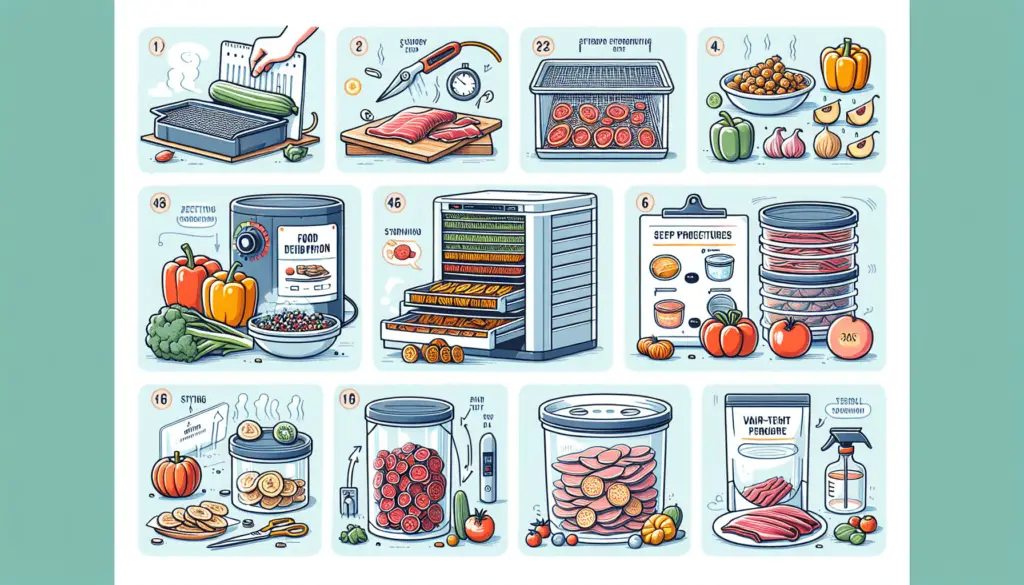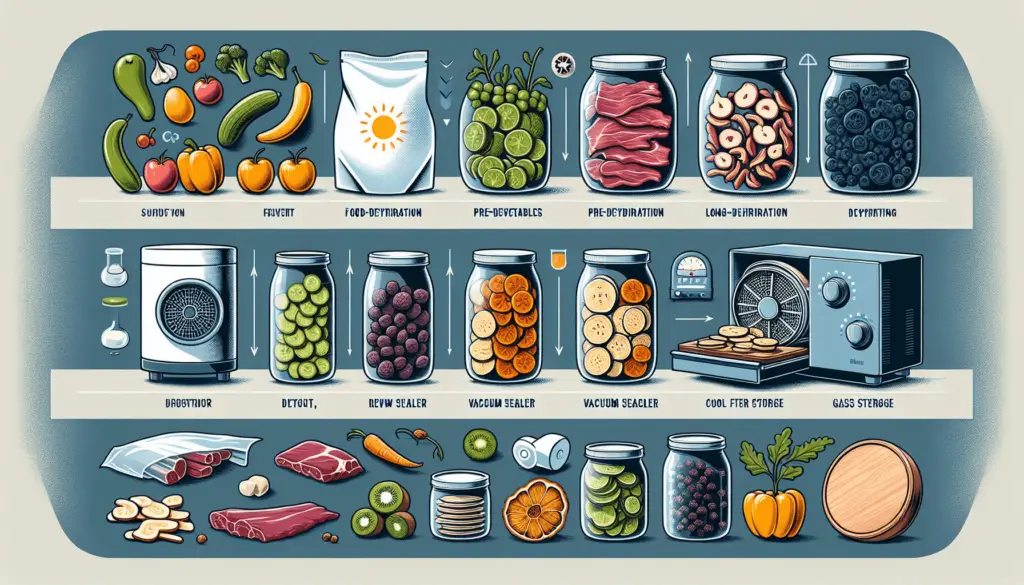Have you ever wondered how you can preserve your favorite fruits and vegetables for longer periods of time? Well, look no further! In this article, we will share with you a simple and efficient method to dehydrate foods for long-term storage. Whether you want to keep a stock of nutritious snacks for your outdoor adventures or simply extend the shelf life of your favorite ingredients, this guide will provide you with all the information you need to get started. So get ready to unlock the secrets of food preservation and enjoy the benefits of dehydrated goodies whenever you please!

Choosing the Right Foods for Dehydration
When it comes to selecting fruits and vegetables for dehydration, there are a few things to keep in mind. First, opt for fruits and vegetables that are ripe but not overripe. This ensures that you capture the maximum amount of flavor and nutrients during the dehydration process. Additionally, choose produce that is free from bruises or blemishes, as these can affect the quality of the dehydrated product. Some popular choices for fruits include apples, bananas, and berries, while vegetables like peppers, tomatoes, and zucchini work well.
Choosing the right meats and seafood for dehydration is equally important. When selecting meats, opt for lean cuts that are free from excessive fat. This helps to prevent spoilage and ensures a longer shelf life for the dehydrated meat. Chicken breast, lean beef, and turkey are all excellent choices. As for seafood, opt for varieties that are sturdy and can withstand the dehydration process, such as salmon or tuna. Remember to buy fresh, high-quality meats and seafood to ensure the best results.
When it comes to herbs and spices, consider the flavor profiles you enjoy and choose accordingly. Herbs like basil, thyme, and rosemary are excellent choices for dehydration, as are spices like chili powder, cumin, and garlic powder. Experiment with different combinations to create your own unique blends.
Preparing the Foods for Dehydration
Before you can begin the dehydration process, it’s important to properly prepare the foods. This involves a few key steps.
Start by cleaning and washing the fruits, vegetables, meats, and seafood. Remove any dirt or debris, and gently scrub the produce to ensure it is clean. For meats and seafood, rinse them thoroughly under cold water.
Next, you may need to peel or remove the skin from certain foods. For fruits like apples or peaches, remove the skin before dehydrating. With vegetables like carrots or potatoes, peeling is often necessary. As for meats, remove any visible fat or skin.
Once the foods are cleaned and peeled, it’s time to slice or dice them into uniform pieces. This helps to ensure even drying and a consistent end product. Use a sharp knife and take your time to achieve the desired results.
In some cases, blanching may be necessary. Blanching involves briefly boiling the food, then immediately plunging it into ice water to halt the cooking process. This step can help to preserve color, texture, and flavor. Blanching is commonly done with vegetables like green beans or broccoli, but it can also be beneficial for certain fruits and meats.
Methods of Dehydration
There are several methods you can choose from when it comes to dehydrating food. Each method has its own benefits and considerations.
Sun drying is one of the oldest and most traditional methods of dehydration. It involves placing the food on trays or racks and exposing it to direct sunlight. It’s important to note that sun drying is highly dependent on weather conditions, and it may take several days to achieve the desired results. This method works well for fruits, vegetables, and certain herbs.
Oven drying is a popular method for those who don’t have access to abundant sunlight or want more control over the drying process. Simply spread the food on baking sheets and place them in a low-temperature oven. Leave the oven door slightly ajar to allow moisture to escape. Keep in mind that oven drying may take longer than other methods and can increase your energy costs.
Dehydrator machines are specifically designed for drying foods. These appliances have trays or shelves that allow for even airflow and temperature distribution. Simply place the prepared food on the trays, set the temperature and timer, and let the dehydrator do its job. Dehydrators are a convenient and efficient option, especially for those who frequently dehydrate food.
Microwave drying is a quick and efficient method that works well for small quantities of food. Place the prepared food on a microwave-safe plate or tray and use the low-power setting to dry it. Remember to check the food regularly to ensure even drying and to prevent overcooking.
Key Factors for Successful Dehydration
To achieve successful dehydration, there are a few key factors to consider.
Temperature and airflow play crucial roles in the dehydration process. For most fruits and vegetables, a temperature range of 125-135°F (52-57°C) is recommended. Meats and seafood usually require temperatures between 145-160°F (63-71°C). Ensure that there is proper airflow to facilitate moisture removal and prevent the growth of bacteria or mold. If using an oven or dehydrator, periodically rotate the trays for even drying.
Proper timing is essential to achieve the desired level of dehydration. The time required will vary depending on the food being dried and the drying method used. Generally, fruits and vegetables take anywhere from 6 to 12 hours, while meats and seafood can take 8 to 16 hours. Check the food regularly and adjust the timing as needed.
Optimal food thickness is another important factor. Slicing fruits, vegetables, meats, and seafood into uniform thickness allows for consistent drying. Thin slices usually dry faster and more evenly compared to thicker pieces. Aim for a thickness of around 1/8 to 1/4 of an inch (3 to 6 mm).

Storing Dehydrated Foods
Proper storage is crucial to maintain the quality and shelf life of dehydrated foods.
Choosing appropriate containers is the first step. Opt for airtight containers made of glass, plastic, or metal. Mason jars, vacuum-sealed bags, or food-grade plastic containers with tight-fitting lids are all great options. Avoid using containers that allow air or moisture to enter, as this can lead to spoilage.
Labeling and organizing your stored dehydrated foods is essential for easy access and inventory management. Clearly label each container with the type of food and the date of dehydration. Organize them in a cool, dry, and dark location, away from heat sources or direct sunlight.
Creating airtight environments is vital to prevent moisture and air from entering the storage containers. You can achieve this by using vacuum-sealed bags, oxygen absorbers, or by removing as much air as possible before sealing.
Storing dehydrated foods in cool and dry locations is essential for maintaining their quality. High temperatures or excessive humidity can lead to spoilage or loss of nutritional value. Aim for a storage temperature of around 50-70°F (10-21°C) and a humidity level of less than 60%.
Rehydrating Dehydrated Foods
Rehydrating dehydrated foods is a simple and convenient process.
Soaking methods are commonly used for certain fruits, vegetables, and some meats. Place the dehydrated food in a bowl and cover it with water. Let it soak for a specific time period, which can vary depending on the food. Once rehydrated, use the food as desired in your recipes.
Hot water rehydration is suitable for many dried foods, including fruits, vegetables, and meats. Simply pour boiling water over the food and let it sit for a few minutes to allow for rehydration. Drain excess water and use the food as you would fresh or cooked ingredients.
Dehydrated foods can be used in a variety of culinary applications. They can be added directly to dishes like soups, stews, or casseroles, or rehydrated and used as standalone ingredients. Experiment with different flavor combinations and techniques to create delicious meals with your dehydrated foods.
Safety and Shelf Life Considerations
Ensuring proper food safety practices is crucial when it comes to dehydrating and storing food.
Start by thoroughly cleaning and sanitizing all surfaces, utensils, and equipment before and after each use. This helps to prevent the growth of bacteria and other harmful microorganisms.
Determining the shelf life of dehydrated foods is important for maintaining their quality and safety. While the shelf life may vary depending on the type of food and storage conditions, dehydrated fruits and vegetables generally have a shelf life of 6 to 12 months. Meats and seafood can last 1 to 2 years if stored correctly. Regularly check for any signs of spoilage, such as off odors, mold, or changes in color or texture.
Tips and Tricks for Dehydration
Here are a few tips and tricks to help you optimize your dehydration process:
- Using lemon juice for color retention: Dip fruits or vegetables in lemon juice before dehydrating to help retain their color and prevent browning.
- Blanching before dehydration: As mentioned earlier, blanching certain foods before dehydration can help preserve color, texture, and flavor.
- Rotating stock regularly: To ensure that you use your dehydrated foods before they expire, practice a first-in, first-out approach. Rotate your stock regularly and use the oldest items first.
- Avoiding mixing strong-flavored foods: Keep strongly flavored foods separate during the dehydration process to prevent flavor transfer. This allows each item to retain its unique taste.
Recipes and Ideas for Dehydrated Foods
Here are some delicious recipes and ideas to get you started with using dehydrated foods:
- Dehydrated fruit snacks: Slice apples, strawberries, or peaches into thin rounds and dehydrate until crisp. Enjoy them as a healthy and tasty snack.
- Trail mix and granola recipes: Combine your favorite dehydrated fruits with nuts, seeds, and granola for a delicious and nutritious on-the-go snack.
- Dehydrated meat jerky: Slice lean beef or turkey into thin strips, marinate in your favorite spices, then dehydrate until chewy and flavorful. This protein-rich snack is perfect for hikes or camping trips.
- Powdered herbs and seasonings: Dehydrate your favorite herbs and spices, then grind them into a fine powder. Use these homemade seasonings to enhance the flavor of your dishes.
Exploring Dehydration Preservation Methods
While dehydrating is a popular preservation method, there are other options to consider as well.
Freeze drying is a method that involves freezing the food and then placing it in a vacuum chamber to remove moisture. This method preserves the texture, flavor, and nutritional value of the food, making it a great option for delicate fruits, vegetables, and even ice cream.
Canning is another alternative to consider. This method involves sealing food in jars or cans and heating them to a specific temperature to kill bacteria and prevent spoilage. Canned foods can have a long shelf life and offer convenience in terms of storage and usage.
Vacuum sealing and using oxygen absorbers are additional methods to prolong the shelf life of dehydrated foods. Vacuum sealing removes air from the packaging, preventing oxidation and moisture absorption. Oxygen absorbers further reduce the oxygen content inside the packaging, creating an inhospitable environment for spoilage-causing organisms.
In conclusion, dehydrating food is an excellent way to preserve it for long-term storage. By choosing the right foods, properly preparing them, and applying the right dehydration techniques, you can enjoy the benefits of tasty, nutritious, and long-lasting foods. Remember to follow proper food safety practices, determine the shelf life of your dehydrated foods, and explore different methods and recipes to make the most of your dehydrated pantry. Happy dehydrating!
